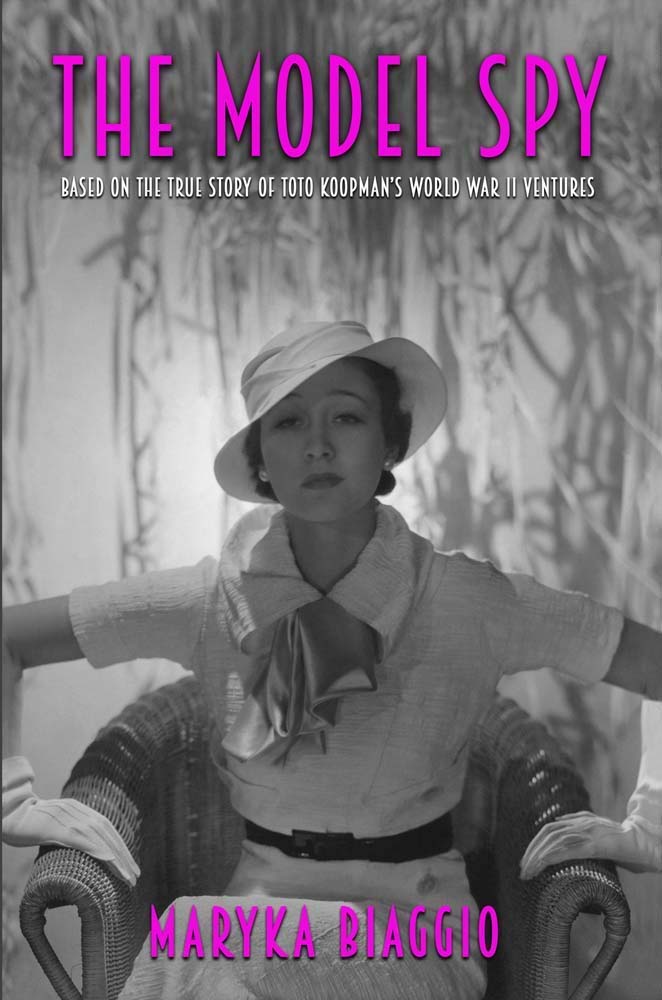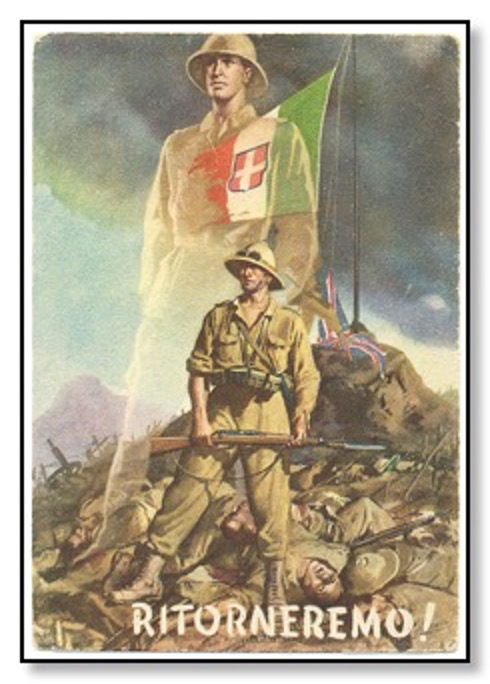
Buy the Book:
Bookshop.org (10% of sales go to indie bookstores)
Sunbury Press
Barnes & Noble
Amazon
Available in paperback and e-book.
The Model Spy
Enter the glamorous yet perilous world of model-turned-spy Toto Koopman in Mussolini’s World War II Italy.
The Model Spy is based on the true story of Toto Koopman, who spies for the Allies and Italian Resistance during World War II. Toto is arguably the first woman to spy for the British Intelligence Service. Operating in the hotbed of Mussolini’s Italy, she courts danger every step of the way. As the war enters its final stages, she faces off against the most brutal of forces-Germany’s Intelligence Service, the Abwehr.
Watch the book trailer:
Praise for The Model Spy
“The story of Toto Koopman is utterly fascinating. Maryka Biaggio’s riveting novel is both heartbreaking and inspiring. With well-researched detail and gripping drama, Biaggio brings to life this audacious, brave, and ultimately enduring woman."
—Liza Nash Taylor, author of In All Good Faith and Etiquette for Runaways
“A sweeping, emotional novel about Toto Koopman, a beautiful model at the height of her allure and fame, who finds herself in the crosshairs of history. Toto Koopman deserves to regain her spot in history. Maryka Biaggio delivers a story of intrigue, adventure, and heart, and gives Toto—finally—her due.”
—Kim Taylor Blakemore, Amazon bestselling author of After Alice Fell
"In this impressive biographical novel, Maryka Biaggio presents World War II spy Toto Koopman as the remarkable woman she proved herself to be. Through engaging first-person narrative, the reader is immersed in the bi-racial Toto’s childhood in Java, her experiences as a model and socialite in pre-War Britain and Europe, and her affairs with the sons of two prominent men, both of whom have the power to save or destroy her—newspaper magnate Lord Beaverbrook and Benito Mussolini. Moving and illuminating, this dramatic depiction of an intrepid individual is an admirable blend of fascinating fact and wonderfully conceived fiction."
—Margaret Porter, award-winning author of The Limits of Limelight and Beautiful Invention: A Novel of Hedy Lamarr
A BookTrib selection: 10 Novels About Women Overcoming Societal Barriers in the 1900s.
If you enjoyed The Model Spy, check out my recommendations for The Best Books about Intrepid Women Spies of World War II at Shepherd.com.
See photos about Toto Koopman and The Model Spy on my Pinterest Page.
World War II: Fascinating Behind-the-Scenes Facts

As authors of historical fiction know well, writers always do more research than they can possibly depict in their novels. In the process of researching The Model Spy, I learned some surprising things about the time and setting. The novel takes place mostly in World War II Italy, and there simply hasn’t been as much fiction or scholarship about wartime Italy as, for instance, France and England.
The Complicated Dance Between Mussolini and Hitler
Hitler greatly admired Benito Mussolini’s 1922 March on Rome—when thousands of fascist supporters strode into the Italian capital, setting the stage for Mussolini’s appointment as prime minister. In fact, Hitler tried to emulate this strategy in his Munich putsch and even acknowledged that Italian fascism was the elder brother of Nazism. When Hitler came to power in 1933, Mussolini publicly praised his takeover.
So it was natural that the two fascist leaders would eventually become allies. But their first meeting in Venice in June 1934 was rife with tension and disappointment. Neither had good things to say about the other after that meeting: Mussolini described Mein Kampf as boring and found Hitler’s ranting monologues annoying; Hitler complained that Mussolini lacked military know-how. Mussolini believed that Italy was superior to Germany in its cultural heritage (think the Holy Roman Empire), while Hitler considered Italy far behind Germany in military and technical prowess (which was true).

Although the two became allies, this was more a marriage of convenience than a meeting of minds. Mussolini surmised that Hitler was poised for military expansion and victory, and he wanted Italy to share in the spoils. Hitler used Italy as a pawn in his military schemes, misleading Mussolini about the timing of his war plans and pushing Italy into military action before the country was adequately equipped for battles. Thus, Italy crumpled in July 1943 when the Allies invaded Italy, which Churchill considered “the soft underbelly” of the Axis. From then on, Mussolini was on the run.
Galeazzo Ciano—Italy’s Doomed Foreign Minister
 In 1930, Galeazzo Ciano married Benito Mussolini's daughter Edda, bringing him into Mussolini’s orbit. Ciano was a hero of Italy’s Ethiopian campaign and, upon his return from the battlefield in 1936, Mussolini appointed him Foreign Minister. Ciano also served as Il Duce’s emissary in numerous meetings with Hitler and his German counterpart, Joachim von Ribbentrop. Ciano began keeping a secret diary about this time. The diary, which survived the war, provides a fascinating glimpse into the Mussolini regime, Axis war strategies, and Il Duce and Ciano’s meetings with Hitler and Ribbentrop.
In 1930, Galeazzo Ciano married Benito Mussolini's daughter Edda, bringing him into Mussolini’s orbit. Ciano was a hero of Italy’s Ethiopian campaign and, upon his return from the battlefield in 1936, Mussolini appointed him Foreign Minister. Ciano also served as Il Duce’s emissary in numerous meetings with Hitler and his German counterpart, Joachim von Ribbentrop. Ciano began keeping a secret diary about this time. The diary, which survived the war, provides a fascinating glimpse into the Mussolini regime, Axis war strategies, and Il Duce and Ciano’s meetings with Hitler and Ribbentrop.
Ciano did not see eye to eye with Mussolini on many matters. Highly skeptical of Mussolini’s military plans, he understood better than Mussolini that Italy was ill-prepared for war. This put him in the perilous position of trying to advise Il Duce against the expansionist dreams he harbored. Ciano even leaked intelligence to Belgium about Hitler’s impending invasion. While Mussolini followed in Hitler’s footsteps and took action against Italy’s Jews, Ciano tried to forestall official government actions against the country’s Jews. Increasingly at odds with Il Duce, he was removed from his post as Foreign Minister in 1943. Ciano, along with his wife and their three children, fled to Germany. But the Nazis returned Ciano to Italy and, against the entreaties of his daughter Edda, Mussolini charged Ciano with treason and had him executed. His last words were “Long live Italy.”
The Muddled Italian Resistance
Much is known about the French Resistance movement, which sprang into action during Germany’s occupation of France and was united in its opposition to the Nazis. But the Italian Resistance predated the war and consisted of numerous and varied political factions opposed to Mussolini’s fascist government.
While a number of Italians admired Mussolini’s charisma and promises of peace and prosperity, by the 1930s many had grown disenchanted with his leadership. When he embarked on his wars in Ethiopia and Albania, life for the average Italian became increasingly difficult, mostly due to food shortages. In addition, shopkeepers and factory and government workers were forced to sign party membership cards and sometimes bused to Mussolini’s rallies and expected to cheer him on. People became secretive and kept their feelings about Mussolini to themselves, knowing that disloyalty could well lead to the castor oil treatment administered by Mussolini’s Blackshirts.
One anti-fascist movement, Giustizia e Libertà (Justice and Liberty), achieved such prominence and influence that two of its leaders, brothers Carlo and Nello Rosselli, were assassinated in 1937 in France, where they had set up their anti-fascist operation. Galeazzo Ciano was allegedly involved in plotting the murders.
By the end of the war, Italians were tired of the hardships and military defeats they’d been subjected to, and in April 1945 partisans hunted down Mussolini and his mistress Clara Petacci as they tried to flee to Switzerland. They were shot, and Mussolini’s corpse was kicked and disfigured. They were hung by their feet in a square in Milan. In the end, the people of Italy had their revenge.
Two days later Hitler committed suicide in his Berlin bunker and the Allies took control of Europe. Italians suffered great hardship during Mussolini’s dictatorship and his ill-fated entry into the war. After the war, there was a short-lived campaign to purge the country of fascists. In 1946 Italy’s weak king, Victor Emmanuel III, abdicated and the country voted by referendum to establish the republic that persists to this day.